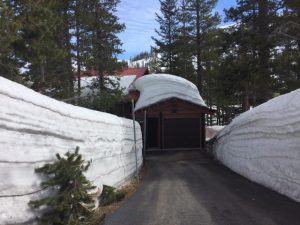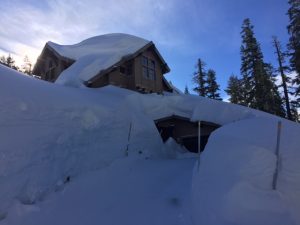
While some of you are understandably counting down the days until the snow melts away and bright green grass grows in its place, others like me and many other avid skiers and boarders continue on our seemingly never-ending quest for fresh powder. Our hope? That the still-increasing 600-plus inch snowcap that blessed Tahoe this winter is not quite yet “capped.” Here is your spring checklist that every Tahoe homeowner needs.
With the start of spring, there is no denying that the snow does seem to be melting quicker than one would have anticipated given the massive accumulation in Tahoe. I dare say record setting snowfall, because it has to be right? It certainly is the most since I have been living in Tahoe. I recently observed dirt in place of mounds of snow in my yard. Despite my love of all things Tahoe and the Tahoe snowcap, I was nonetheless excited to see what seemed like a long lost friend.
Once the snow melts and the dirt emerges, it is time to put down the shovel, take a deep breath and assess how our homes have (quite literally) weathered the storm. It is a good idea to “start at the bottom” and “go up from there.”
First, take a look in your sub-area (crawl space or basement for example) and make sure there is no standing water. Peering into the unknown abyss of the sub area may be intimidating (it certainly is at my house) but fingers crossed, there will be no water accumulation or damage. This winter, the majority of the home inspections I attended exposed wet sub-areas or in some unfortunate cases, they were completely full of water.
“I can’t inspect a house if the crawl space is full of water, there is no way to properly see the footings of the house and it can be dangerous” commented home inspector Bill Bergstedt.
If you do find water, the use or installation of a sump pump is a good idea — and an even better idea is to have a licensed plumber install it. The local plumbers know the proper technique as some of the sump pumps must be installed under the ground level.
In Tahoe in particular, there are certain neighborhoods that are generally considered “wet neighborhoods,” and these may need more attention than others. If you are going to be purchasing a home in the near future, ask your Realtor or a long-time local about these areas. A home inspector will be able to tell if there is evidence of prior moisture issues, as water leaves a mineral efflorescence film on the foundation walls.
All homeowners also should inspect their attics for moisture and/or water accumulation. This should be done each spring. It is not uncommon to observe fungus in either the attic or sub area. If you have any concerns, you should hire a local contractor or pest company to further inspect the area. Also, make sure to open all exterior vents to allow the moisture to escape during our dry summer months in the not too distant future. Some homes will need additional venting to allow for air flow, which allows these areas to dry out and prevents issues in the future.

The next item on the agenda is to walk the perimeter of your house and inspect for any loose siding, decking and/or railings that might need a little adjusting. The heavy amount of snow sitting against the house is generally not a good thing — unless of course you have always had the strong desire to be an Eskimo and experience igloo living. The snow as it melts can cause moisture to penetrate the exterior siding and can cause dry rot. In addition to the snow issue, the harsh high-elevation sunshine can wreak havoc. It might be time to have the exterior painted or stained — there are many houses in our neighborhoods that need stain desperately. Not only does it help protect the house in question, but it does the neighbors a favor as well.
Regarding the roof, if you know it is older, a roof inspection may be in order to check for any loose or missing shingles, or if it is a metal roof, to evaluate for loose or missing screws, dents or torn flashing. Flashing is the material that allows water to properly drain from the roof to the ground without traveling down the side of the house. If you have gutters, they will most likely need an adjustment, although not always practical here in snow country.
Throughout the winter, I noticed some of us had our roofs shoveled.
“When in doubt shovel it,” says Jared Clark, a local general contractor. “Most of our Tahoe houses should be built for the snow but some have flat roofs, and are older construction.”
Personally, I didn’t shovel my roof but I have noticed some new settling cracks at my house, which others have mentioned to me as well. Of course, if you see major cracks and are concerned, be smart and hire a local contractor to analyze and ensure that there are no major issues.
Next, it’s time to stretch the neck and go outside for a walk. Look up for any dead tree limbs that could potentially fall onto your house. If you have any questionable trees that might be leaning or dead, call an arborist and do so quickly. If you live adjacent to land owned by a public agency, such as the Forest Service, alert the applicable authorities so they can come out and evaluate. I had a tree in the neighboring California Tahoe Conservancy lot that was heavily leaning toward my house. I called them and they had it cut down within just a few days, which was both impressive and reassuring.
Spring checklist every Tahoe homeowner needs
Finally, the last spot on the checklist is to make sure your driveway drains aren’t clogged and full of debris; also, don’t forget to check for any new holes that animals may have created so they could settle in for the winter. Raccoons and squirrels are known squatters and of course, be on the lookout for the occasional mama bear and her cubs. In Tahoe, it is very common to have our local animals move into attics, sub areas, garages and under decks as the “second homeowner,” particularly when the house isn’t occupied on a regular basis.
We all will experience some issues from the snow this year — whether it’s an improved attitude from skiing or snowboarding too much (never too much, I say), sore wrists from the extra shoveling or a new appreciation for creeks and rivers as their waters fill up Big Blue. Just don’t neglect your house as these Tahoe homes need attention. But once summer officially arrives and we put our shovels away, we will look at them as distant relatives. It was real and I will miss you … until we meet again.
Jennifer Fortune is a Realtor for Chase International South Tahoe Realty. Fellow Realtors, if you have ideas for stories or would like to share a story, please contact Fortune at jfortune@chaseinternational.com.

Leave a Reply